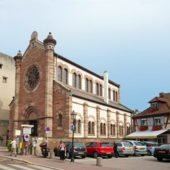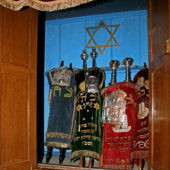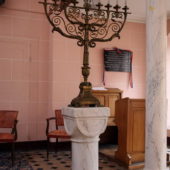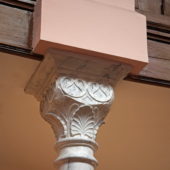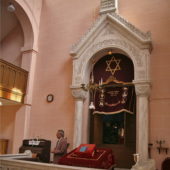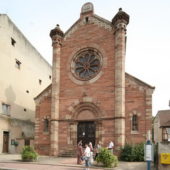Obernai was spared much of World War II, leaving the synagogue authentic.
My wife and I visited Obernai in October of 2006 to photograph the synagogue. The president of the Jewish community, who is also the director general of Obrernai’s finest hotel, escorted us through the synagogue. We asked about the impact of the Holocaust upon Obernai’s Jews. He said that all of his family left Europe for the USA after Krystallnacht except his grandparents and his father, who was 16 at the time. He is often asked why his father didn’t leave. “He couldn’t leave his parents,” said our escort. His grandfather, who like our escort is the head of Obernai’s Jewish community, didn’t leave because he considered himself a Frenchman. He stayed until one day a friend said to him, “Henri, you must leave tonight. They are coming for you tomorrow.” That night the family left. But they were captured. Henri and his son survived; no one knows what happened to our escort’s grandmother. “There is no record of her on any transport,” he said, almost in tears.
Jews were first documented to have settled in Obernai in 1215. In the 14th century, they were accused of having caused the Black Death and sentenced to die at the stake. In 1349 they were accused of poisoning wells. Whether by emigration or execution the Jews of Obernai became extinct until the 15th century. There is an ancient Jewish quarter and on the ruelle des Juifs (Jew’s Lane), where an earlier Synagogue was built in 1454, there is a weathered Hebrew inscription around the doorway. In the Jewish quarter and above the arcade is the Hebrew date 5456 (1696 AD). After 1647, when Obernai came under French rule, Jews trickled back into the city. By 1720, twenty one Jewish families lived in Obernai and in 1749 they built a synagogue. The current Synagogue was built in 1876 at today’s prominent site on the busy rue de Selestat.
In 1936 the Jewish community numbered 138 people yet by 1940 all had fled Obernai due to WWII. The interior of the Synagogue was destroyed by the Nazis in WWII and used to store pigs. After the War many of those Jews who survived the Holocaust returned, restoring the Synagogue in 1948. By 1970 the Jewish population was 70 and in 2006 approximately 100 Jews live in the town.
The 1876 Synagogue was built of pink sandstone in the neo-Romanesque style. The Jewish community numbered 205 members at the time it was built. Twin narrow towers with turrets flank the entranceway, with two-toned arched brickwork around the front door and a beautiful round flower-shaped stained-glass window above it. Peach walls with arches tapering down into white marble-effect Corinthian columns support the upstairs balcony along the sides and back of the sanctuary. Sets of two arched, paned windows adorn the sides of the prayer-room, each pair set into an arched inset. The Aron-Kodesh is situated against the East wall on the bimah, in elaborately carved white stone. Two tablets inscribed in Hebrew with The Ten Commandments sit on top of it. A white, intricately carved stone balustrade stands in front of the bimah. The tivah (reader’s desk) is on the bimah, in front of the Aron Kodesh. An intricately worked, brass menorah rests on a beautiful white stand on the bimah, off to the side. This is one of original relics from before WWII. Black and white tiling with varied motifs decorate the floor and wood pews fill the prayer-room.
While there is a strong Jewish community in Obernai it is not large enough to afford a full-time rabbi. Services are held on holidays and special occasions by a rabbi who is from Denmark and lives in nearby Strasbourg.
The history of the Obernai Jewish community is like so much of Europe’s: periods of relative freedom and prosperity laced by periods of persecution and tragedy. While the community is currently enjoying a peaceful existence, there are instances of anti-Semitism.

